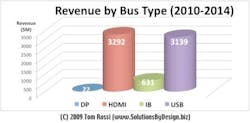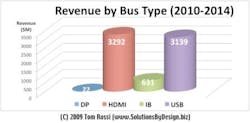IGI: Active optical cable dollars will be mainly in consumer apps
MARCH 29, 2010 By Stephen Hardy -- While much of the discussion around active optical cables (AOCs) has focused on its potential role in data centers and high-performance computing, the real money for AOC vendors will soon be in consumer applications. So says market research and analysis firm Information Gatekeepers Inc. (IGI) in the first issue of what it promises will be a quarterly report service on the AOC market.
Like IGI’s annual AOC report, the quarterly update is authored by consultant Tom Rossi. As the chart below illustrates, Rossi sees plenty of business to be had in markets where HDMI and USB 3.0 interfaces are common (DP = DisplayPort; figures are in millions of dollars).
USB 3.0 in particular appears to be a point of emphasis among developers of consumer electronics; Rossi notes that the most recent CES devoted an entire pavilion to the technology. While copper cabling for the specification’s 5-Gbps speeds are available, they are 6-8 mm thick and run only 3 m, which is 2 m shorter than USB 2.0 cables. Not surprisingly, thicker, bulkier cables lead to larger connectors as well.
Rossi and IGI therefore see this space as a ripe market for AOCs. Optical cables would likely be thinner (2-3 mm), lighter, and more flexible, the report asserts. Rossi notes that Intel has taken potshots at copper-based USB 3.0 interconnect in building the case for its 10-Gbps Light Peak optical interconnect.
However, Intel might want to tone down this rhetoric. IGI has previously suggested that Light Peak could have a major impact on the AOC market (see “IGI: Light Peak initiative good for active optical cable”). However, Rossi says that the high-speed interconnect technology “has decidedly taken a much slower path to market than any previous IO initiative to emerge from Intel. Beyond the early hype we have seen few details emerge to support earlier claims that this will have a significant and broad industry impact. Indeed, we have not heard any details on formation of any industry standards efforts to promote Light Peak, nor has Intel formally announced which current protocols will be carried in the first product instantiations it claims to be getting ready for 2010.”
However, Apple’s iPad announcement may help pick up the slack, Rossi suggests. Initial iPads likely will sport a USB 2.0 interface, Rossi says. Users may find this a bit slower than they’d like, which opens the door to USB 3.0 and additional opportunities for compliant AOCs. Rossi also doesn’t rule out a custom AOC that would combine USB 3.0 capability with an even higher data rate of Apple’s choosing.
Overall, Rossi predicts that InfiniBand-driven enterprise and computing interconnect applications will drive AOC revenue for most of this year, at least. But as consumer-based designs become available by the end of 2010 or early in 2011, the revenue flow will switch in their direction.
More information about the quarterly updates can be found on the IGI site.

